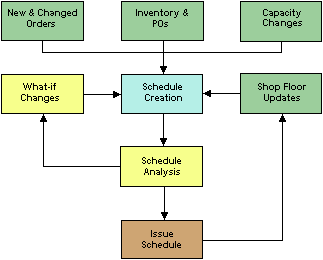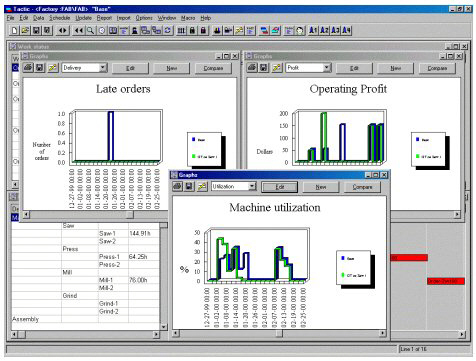TACTIC Concepts
 Planning and scheduling is the what-if process of deciding what orders should be worked on, in what sequence (e.g., priority), with what limited capacity (e.g., machines, tools, and labor) and limited material (e.g., on-hand and promised), and at what time.
Planning and scheduling is the what-if process of deciding what orders should be worked on, in what sequence (e.g., priority), with what limited capacity (e.g., machines, tools, and labor) and limited material (e.g., on-hand and promised), and at what time.
As new orders, problems, and changes occur, what-if problem solving is the iterative process of rescheduling to see adverse effects, trying what-if ideas (e.g., change priority, capacity, or material allocation) to reduce the negative impact, and comparing schedules to decide the best course of action.
What-if Tool
Many factors can affect decisions that try to balance what's good for customers with what's good for business. TACTIC can handle some decisions efficiently, you can handle other decisions effectively, and there are decisions that are best reached by you interacting with TACTIC.
TACTIC is a visual interactive what-if tool. It allows you to quickly combine formal data (e.g., orders, routings, inventory, bills, and capacity limits) and intuition (e.g., what-if ideas) to create detailed schedules. It lets you visualize problems, and interactively investigate, change, and add data to find the best what-if ideas to resolve the problems.
TACTIC uses your computer for the mechanics of planning and scheduling. That is, calculating elapsed times, checking lists of what is available and what is allocated, and ensuring that production is scheduled in the proper sequence.
Visual tool
TACTIC gives you visual analysis feedback about what it did using Gantt charts, tables, and comparison graphs. TACTIC calculates violations (e.g., late orders) and their causes (e.g., bottlenecked machine). It also recommends one or more actions (e.g., add more labor) to correct the violations. Consequently, you may want to try one or more of the corrective actions as different what-if ideas. You would then reschedule to see if the what-if changes resolved the violations.
For example, as a what-if idea you might identify and provide TACTIC information it needs (e.g., allowing overtime) to consider additional scheduling alternatives to correct a late order caused by a bottleneck. You might then compare the alternative using various business metrics (e.g., profit, utilization, on-time delivery) to analyze and select the best alternative.
The TACTIC screen below shows graphs of three different business metrics. Two different what-if ideas are plotted on each.

